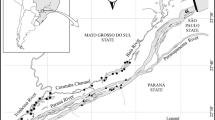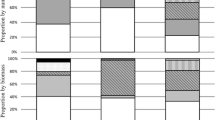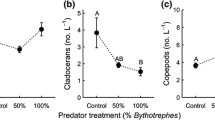Abstract
Large tropical rivers are increasingly affected by dam construction, which generally implies alteration of flow regimes, increased water transparency, decline of native species and proliferation of invasive alien species. The potential of native Neotropical piscivores to provide biotic resistance to alien fish invaders and its interaction with water turbidity was investigated through mesocosm experiments. Three invasive and two native fish species were offered as prey to three native piscivores of the Paraná river in 1000 L tanks. After 48 h, prey survival was compared among trials with and without the piscivores and in turbid (~ more preserved systems) versus clear water (~ disturbed systems by damming) treatments. Prey survival, particularly of the invasive species, was significantly lower in turbid water in the presence of predators (~ 45.9% versus ~ 53.7% in clear water). Piscivores preyed more on smaller individuals in clear water and on larger preys in turbid water. Although vulnerability to predation was prey-specific, our results support the potential of native piscivores to provide biotic resistance against alien freshwater species. Water turbidity mediated the predator–prey interactions and our results confirm the hypothesis that decreased turbidity caused by dams’ construction can affect predation efficiency of native piscivores and increase the abundance of alien fish.




Similar content being viewed by others
References
Agostinho, A. A., L. C. Gomes, H. I. Suzuki & H. F. Júlio Jr., 2003. Migratory fishes of the upper Paraná River basin, Brazil. In Carolsfeld J., B. Harvey, C. Ross, A. Baer (eds), Migratory fishes of South America: Biology, fisheries and conservation status. World Fisheries Trust, Victoria.
Agostinho, A. A., L. C. Gomes, S. Verissimo & E. K. Okada, 2004. Flood regime, dam regulation and fish in the Upper Paraná River: effects on assemblage attributes, reproduction and recruitment. Reviews in Fish Biology and Fisheries 14: 11–19.
Agostinho, A. A., F. M. Pelicice, A. C. Petry, L. C. Gomes & H. F. Júlio Jr., 2007. Fish diversity in the upper Paraná River basin: habitats, fisheries, management and conservation. Aquatic Ecosystem Health 10: 174–186.
Agostinho, A. A., F. M. Pelicice & L. C. Gomes, 2008. Dams and the fish fauna of the neotropical region: impacts and management related to diversity and fisheries. Brazilian Journal of Biology 68: 1119–1132.
Agostinho, A. A., L. C. Gomes, N. C. L. Santos, J. C. G. Ortega & F. M. Pelicice, 2016. Fish assemblages in neotropical reservoirs: colonization patterns, impacts and management. Fisheries Research 173: 26–36.
Almeida, V. L. L., N. S. Hahnm & A. E. A. Vazzoler, 1997. Feeding patterns in five predatory fishes of the high Parana River floodplain (PR, Brazil). Ecology of Freshwater of Fish 6: 123–133.
Bajer, P. G., C. J. Chizinski, J. J. Silbernagel & P. W. Sorensen, 2012. Variation in native micro-predator abundance explains recruitment of a mobile invasive fish, the common carp in a naturally unstable environment. Biological Invasions 14: 1919–1929.
Barletta, M., A. J. Jaureguizar, C. Baigun, N. F. Fontoura, A. A. Agostinho, V. M. Almeida-Val, A. L. Val, R. A. Torres, L. F. Jimenes-Segura, T. Giarrizzo, N. N. Fabré, V. S. Batista, C. Lasso, D. C. Taphorn, M. F. Costa, P. T. Chaves, J. P. Vieira & M. F. Corrêa, 2010. Fish and aquatic habitat conservation in South America: a continental overview with emphasis on Neotropical systems. Journal of Fish Biology 76: 2118–2176.
Bosher, B. T., S. H. Newton & M. L. Fine, 2006. The spines of the channel catfish, Ictalurus punctatus, as an anti-predator adaptation: an experimental study. Ethology 112: 188–195.
Bozza, A. N. & N. S. Hahn, 2010. Uso de recursos alimentares por peixes imaturos e adultos de espécies piscívoras em uma planície de inundação neotropical. Biota Neotropica 10: 217–226.
Britton, J. R. & M. L. Orsi, 2012. Non-native fish in aquaculture and sport fishing in Brazil: economic benefits versus risks to fish diversity in the upper River Paraná Basin. Reviews in Fish Biology and Fisheries 22: 555–565.
Bulla, C. K., L. C. Gomes, L. E. Miranda & A. A. Agostinho, 2011. The ichthyofauna of drifting macrophyte mats in the Ivinhema River, upper Paraná River basin, Brazil. Neotropical Ichthyology 9: 403–409.
Bunn, S. E. & A. H. Arthington, 2002. Basic principles and ecological consequences of altered flow regimes for aquatic biodiversity. Journal of Environmental Management 30: 492–507.
Clavero, M. & E. García-Berthou, 2005. Invasive species are a leading cause of animal extinctions. Trends in Ecology & Evolution 20: 110.
Collyer, C. E., 1997. Exaggeration of the important, how the eyes sees edges. Maritimes 39: 4–5.
Dias, R. M., J. C. Barbosa, L. C. Gomes & A. A. Agostinho, 2017. Effects of macrophyte complexity and hydrometric level on fish assemblages in a Neotropical floodplain. Environmental Biology of Fishes 100: 1–14.
Ferreira, F. A., R. P. Mormul, S. M. Thomaz, A. Pott & V. J. Pott, 2011. Macrophytes in the upper Paraná river floodplain: checklist and comparison with other large South American wetlands. Revista de Biología Tropical 59: 541–556.
Figueiredo, B. R. S., R. P. Mormul & E. Benedito, 2013. Non-additive effects of macrophyte cover and turbidity on predator-prey interactions involving an invertivorous fish and different prey types. Hydrobiologia 71: 21–28.
Figueiredo, B. R. S., R. P. Mormul & E. Benedito, 2015. Structural complexity and turbidity do not interact to influence predation rate and prey selectivity by a small visually feeding fish. Marine and Freshwater Research 66: 170–176.
Figueiredo, B. R. S., R. P. Mormul, B. B. Chapman, L. A. Lolis, L. F. Fiori & E. Benedito, 2016. Turbidity amplifies the non-lethal effects of predation and affects the foraging success of characid fish shoals. Freshwater Biology 61: 293–300.
Fine, M. L. & F. Ladich, 2003. Sound production, spine locking and related adaptations. In Kapoor, B. G., G. Arratia, M. Chardon & M. Diogo (eds.), Catfishes. Science Publishers, Enfield.
Fugi, R., K. D. G. Luz-Agostinho & A. A. Agostinho, 2008. Trophic interaction between an introduced (peacock bass) and a native (dogfish) piscivorous fish in a Neotropical impounded river. Hydrobiologia 607: 143–150.
Gill, A. B., 2003. The dynamics of prey choice in fish: the importance of prey size and satiation. Journal of Fish Biology 63: 105–116.
Gregory, R. S. & C. D. Levings, 1998. Turbidity reduces predation on migrating juvenile Pacific salmon. Transactions of the American Fisheries Society 127: 275–285.
Havel, J. E., C. E. Lee & M. J. Vander Zanden, 2005. Do reservoirs facilitate invasions into landscapes? Bioscience 55: 515–525.
Howes, G., 1982. Review of the generous Brycon (Teleostei: Characoidei). Bulletin of the British Museum (Natural History) 43: 1–47.
Horppila, J. & A. Liljendahl-Nurminen, 2005. Clay-turbid interactions may not cascade - a reminder for lake managers. Restoration Ecology 13: 242–246.
Johnson, P. T. J., J. D. Olden & M. J. Vander Zanden, 2008. Dam invaders: impoundments facilitate biological invasions into freshwaters. Frontiers in Ecology and the Environment 6: 357–363.
Juanes, F., J. A. Buckel & F. S. Scharf, 2002. Feeding ecology of piscivorous fishes. In Hart, P. J. B. & J. D. Reynolds (eds.), Handbook of fish biology and fisheries. Blackwell Publishing, Oxford.
Júlio Jr., H. F., C. Dei Tós, A. A. Agostinho & C. S. Pavanelli, 2009. A massive invasion of fish species after eliminating a natural barrier in the upper rio Paraná basin. Neotropical Ichthyology 7: 709–718.
Langeani, F., O. T. Oyakawa, O. A. Shibatta, C. S. Pavanelli & L. Casatti, 2007. Diversidade da ictiofauna do Alto Rio Paraná: composição atual e perspectivas futuras. Biota Neotropica 7: 181–197.
Liew, J. H., H. H. Tan & D. C. Yeo, 2016. Dammed rivers: impoundments facilitate fish invasions. Freshwater Biology 61: 1421–1429.
Lowe-McConnell, R. H., 1987. Ecological studies in Tropical fish communities. University Press, Cambridge.
Lowe-McConnell, R. H., 1991. Ecology of cichlids in South American and African waters, excluding 540 the African great lakes. In keenleyside, M. H. A. (ed). Cichlid Fishes: Behaviour, Ecology and 541 Evolution. Chapman & Hall, New York.
Luz-Agostinho, K. D. G., A. A. Agostinho, L. C. Gomes & H. F. Júlio Jr., 2008. Influence of flood pulses on diet composition and trophic relationships among piscivorous fish in the upper Paraná River floodplain. Hydrobiologia 607: 187–198.
Macia, A., K. G. S. Abrantes & J. Paula, 2003. Thorn fish Terapon jarbua (Forskal) predation on juvenile white shrimp Penaeus indicus H. Milne Edwards and brown shrimp Metapenaeus monoceros (Fabricius): the effect of turbidity, prey density, substrate type and pneumatophore density. Journal of Experimental Marine Biology and Ecology 291: 29–56.
Mazur, M. M. & D. A. Beauchamp, 2003. A comparison of visual prey detection among species of piscivorous salmonids: effects of light and low turbidities. Environmental Biology of Fish 67: 397–405.
Miner, J. G. & R. A. Stein, 1996. Detection of predators and habitat choice by small bluegills: effects of turbidity and alternative prey. Transactions of the American Fisheries Society 125: 97–103.
Monteiro, A. B. & L. D. B. Faria, 2016. Simple assumptions predicts prey selection by piscivorous fishes. Ecological Complexity 28: 158–162.
Nilsson, P. A. & C. Brönmark, 2000. Prey vulnerability to a gape-size limited predator: behavioural and morphological impacts on northern pike piscivory. Oikos 88: 539–546.
Oliveira, A. G., H. I. Suzuki, L. C. Gomes & A. A. Agostinho, 2015. Interspecific variation in migratory fish recruitment in the Upper Paraná River: effects of the duration and timing of floods. Environmental Biology of Fishes 98: 1327–1337.
Padial, A. A. & S. M. Thomaz, 2008. Prediction of the light attenuation coefficient through the Secchi disk depth: empirical modeling in two large Neotropical ecosystems. Limnology 9: 143–151.
Pangle K.L., T.D. Malinich, D.B. Bunnell, D.R. DeVries & S.A. Ludsin 2012. Context-dependent planktivory: interacting effects of turbidity and predation risk on adaptive foraging. Ecosphere, 3: art114.
Pelicice, F. M., A. A. Agostinho & S. M. Thomaz, 2005. Fish assemblages associated with Egeria in a tropical reservoir: investigating the effects of plant biomass and diel period. Acta Oecologica 27: 9–16.
Pelicice, F. M. & A. A. Agostinho, 2008. Fish-passage facilities as ecological traps in large Neotropical rivers. Biological Conservation 22: 180–188.
Pereira, L. S., A. A. Agostinho & L. C. Gomes, 2014. Eating the competitor: a mechanism of invasion. Hydrobiologia 746: 223–231. https://doi.org/10.1007/s10750-014-2031-1.
Pereira, L. S., L. F. C. Tencatt, R. M. Dias, A. G. Oliveira & A. A. Agostinho, 2017. Effects of long and short flooding years on the feeding ecology of piscivorous fish in floodplain river systems. Hydrobiologia 795: 65–80. https://doi.org/10.1007/s10750-017-3115-5.
Persson, L. & P. Eklöv, 1995. Prey refuges affecting interactions between piscivorous perch and juvenile perch and roach. Ecology 76: 70–81.
Pohlmann, K., F. W. Grasso & T. Breithaupt, 2001. Tracking wakes: the nocturnal predatory strategy of piscivorous catfish. Proceedings of the National Academy of Sciences 98: 7371–7374.
Pohlmann, K., A. Jelle & B. Thomas, 2004. The importance of the lateral line in nocturnal predation of piscivorous catfish. Journal of Experimental Biology 207: 2971–2978.
Robertson, M. J., D. A. Scruton & K. D. Clarke, 2007. Seasonal effects of suspended sediment on the behavior of juvenile Atlantic salmon. Transactions of the American Fisheries Society 136: 822–828.
Rocha, R. R. A., S. M. Thomaz, P. Carvalho & L. C. Gomes, 2009. Modeling chlorophyll-a and dissolved oxygen concentration in tropical floodplain lakes (Paraná River, Brazil). Brazilian Journal of Biology 69: 491–500.
Santos, L. N., F. G. Araújo & D. S. Brotto, 2008. Artificial structures as tools for fish habitat rehabilitation in a neotropical reservoir. Aquatic Conservation 18: 896–908.
Santos, A. F. G. N., L. N. Santos & E. García-Berthou, 2009. Could native predators help to control invasive fishes Microcosm experiments with the Neotropical characid Brycon orbignyanus. Ecology of Freshwater of Fish 18: 491–499.
Santos, A. F. G. N., L. N. Santos & F. G. Araújo, 2011. Digestive tract morphology of the Neotropical piscivorous fish Cichla kelberi (Perciformes: cichlidae) introduced into an oligotrophic Brazilian reservoir. Revista de Biología Tropical 59(3): 1245–1255.
Santos, A. F. G. N., C. Alcaraz, L. N. Santos, C. Hayashi & E. García-Berthou, 2012. Experimental assessment of the effects of a Neotropical nocturnal piscivore (Pseudoplatystoma corruscans) on juvenile native and invasive fishes. Neotropical Ichthyology 10: 167–176.
Santos, A. F. G. N., E. García-Berthou, C. Hayashi & L. N. Santos, 2013. When habitat complexity increases predation risk: experiments with invasive and neotropical native fishes. Marine Freshwater Research 64: 752–760.
Santos, A. F. G. N., P. R. O. Carrera, M. Aronovich & L. N. Santos, 2014. Preferência alimentar de juvenis de lambari-cachorro, Oligosarcus hepsetus, em relação a duas espécies de presas de peixe em ambiente controlado. Ciência Rural 44: 307–313.
Saunders, D. L., J. J. Meeuwig & A. C. J. Vincent, 2002. Freshwater protected areas: strategies for conservation. Conservation Biology 16: 30–41.
Skov, C., S. Berg, L. Jacobsen & N. Jepsen, 2007. Habitat use and foraging success of 0 + pike (Esox lucius) in experimental ponds related to prey fish, water transparency and light intensity. Ecology of Freshwater of Fish 11: 65–73.
Skóra, F., V. Abilhoa, A. A. Padial & J. R. S. Vitule, 2015. Darwin’s hypotheses to explain colonization trends: evidence based on a quasi-natural experiment. Diversity and Distributions 5: 583–594.
Snickars, M., A. Sandstrom & J. Mattila, 2004. Antipredator behaviour of 0-year Perca fluviatilis: effect of vegetation density and turbidity. Journal of Fish Biology 65: 1604–1613.
Tabachnick, B. G. & L. S. Fidel, 2001. Computer assisted research design and analysis. Allyn e Bacon, Boston.
Thompson, K. A., J. E. Hill & L. G. Nico, 2012. Eastern mosquitofish resists invasion by nonindigenous poeciliids through agonistic behaviors. Biological Invasions 14: 1515–1529.
Vitule, J. R. S., 2009. Introduction of fishes in Brazilian continental ecosystems: review, comments and suggestions for actions against the almost invisible enemy. Neotropical Biology and Conservation 4: 111–122.
Winemiller, K. O., P. B. McIntyre, L. Castello, E. Fluet-Chouinard, T. Giarrizzo, S. Nam, I. G. Baird, W. Darwall, N. K. Lujan, I. Harrison, M. L. J. Stiassny, R. A. M. Silvano, D. B. Fitzgerald, F. M. Pelicice, A. A. Agostinho, L. C. Gomes, J. S. Albert, E. Baran, M. Petrere-Júnior, C. Zarfl, M. Mulligan, J. P. Sullivan, C. C. Arantes, L. M. Sousa, A. A. Koning, D. J. Hoeinghaus, M. Sabaj, J. G. Lundberg, J. Armbruster, M. L. Thieme, P. Petry, J. Zuanon, G. T. Vilara, J. Snoeks, C. Ou, W. Rainboth, C. S. Pavanelli, A. Akama, A. van Soesbergen, & L. Saenz, 2016. Balancing hydropower and biodiversity in the Amazon, Congo, and Mekong. Science 351: 128–129, http://www.sciencemag.org/cgi/doi/10.1126/science.aac7082.
Winnie Jr., J. & S. Creel, 2016. The many effects of carnivores on their prey and their implication for trophic cascades, and ecosystem structure and functioning. Food Webs. https://doi.org/10.1016/j.fooweb.2016.09.002.
Wolter, C. & R. Arlinghaus, 2003. Navigation impacts on freshwater fish assemblages: the ecological relevance of swimming performance. Reviews in Fish Biology and Fisheries 13: 63–89.
Acknowledgements
This work was funded by CNPq, Conselho Nacional de Desenvolvimento Científico e Tecnológico, Brazil (graduate grant to A.F.G.N. Santos, code 142572/2004-7 and code 210199/2006-7; Edital Universal, code 478541/2004-0) and Programme Alßan of the European Union (Programme of High Level Scholarships for Latin America, grant to L.N. Santos). Further financial support was provided by the Spanish Ministry of Economy and Competitiveness (projects CGL2015-69311-REDT and CGL2016-80820-R), the Government of Catalonia (ref. 2014 SGR 484), the European Commission (COST Action TD1209), Fundação Carlos Chagas Filho de Amparo à Pesquisa do Estado do Rio de Janeiro (research grant to LNS, E-112.644/2012, E-26/202.840/2015), Conselho Nacional de Desenvolvimento Científico e Tecnológico (CNPq) (research grant to LNS, ref. 312194/2015-3) and particularly CAPES (PVE-visiting professorship to EGB, ref. 88881.068352/2014-01). We especially thank Dr. A.A. Agostinho, Dr. A. Bialetzki and Dr. H.F. Júlio Jr, from Núcleo de Pesquisas em Limnologia, Ictiologia e Aquicultura (Nupelia, UEM, Brazil), for providing the infrastructure for the laboratory experiments. We thank the two anonymous reviewers and the Associate Editor in Chief S. M. Thomaz whose suggestions deeply improved the manuscript quality.
Author information
Authors and Affiliations
Corresponding author
Additional information
Guest editors: John E. Havel, Sidinei M. Thomaz, Lee B. Kats, Katya E. Kovalenko & Luciano N. Santos / Aquatic Invasive Species II
Rights and permissions
About this article
Cite this article
Santos, A.F.G.N., García-Berthou, E., Hayashi, C. et al. Water turbidity increases biotic resistance of native Neotropical piscivores to alien fish. Hydrobiologia 817, 293–305 (2018). https://doi.org/10.1007/s10750-018-3548-5
Received:
Revised:
Accepted:
Published:
Issue Date:
DOI: https://doi.org/10.1007/s10750-018-3548-5




